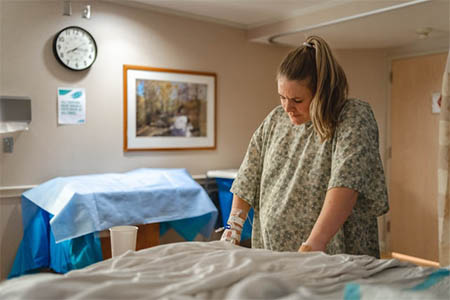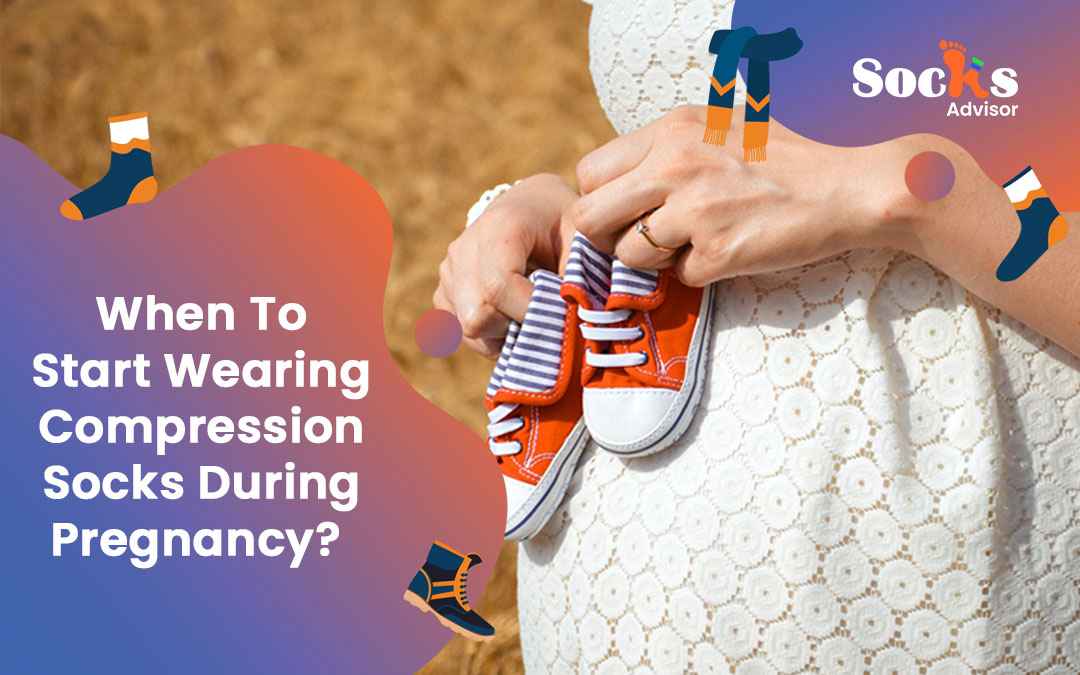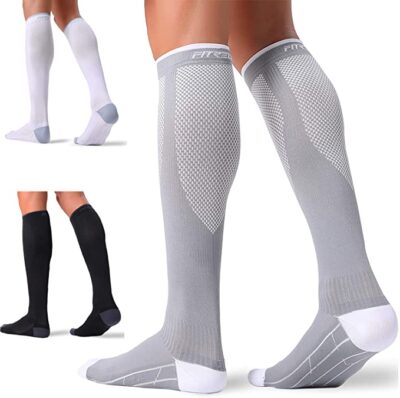Entailing a comprehensive guide on when to start wearing compression socks during pregnancy comprised of experiences and scientific research.
- What are compression socks? And how can they help with the pregnancy?
- When to start wearing compression socks during Pregnancy?
- Start wearing compression socks if you are suffering from:
- A Retrospective study by Mary Ann Liebert on analyzing the methods applied in the prevention and treatment of lower limb edema in pregnant women:
- Understanding if Vascularization is normal for everyone in pregnancy and when compression socks can come to the rescue:
- What causes the legs to swell in pregnancy?
- How do I choose the right compression socks for tackling pregnancy?
- When not to wear Compression socks?
- My final thought
Hey, mommy-to-be,
The moment one gets to know about bringing new life to the world is unexplainable, no description can do justice to the joy one feels at that moment. Where one end of pregnancy brings with itself the heart pondering happiness. On the other end, it also invites swelling, vomiting, and getting out all your nerves with one pain jerk.
Out of many common pregnancy norms, leg swelling and pain make their way toward the lead. You would have witnessed how surprisingly the foot size of pregnant women gets varied right from the first trimester (the duration of three months in pregnancy is declared as one trimester).
This increased foot size not only costs you money to buy new footwear but also invites swelling, pain, and ultimately difficulty in walking disrupting your plans of a beautiful pregnancy period of which you would have dreamt.
But don’t you worry, because there is a solution to every problem which in this case happens to be the compression socks. These rightly fitting socks are capable of easing your leg pain but there are specific rules to wear them.
To know what they are and when to start wearing compression socks during pregnancy, stay with us till the end since in this article we are going to unfold many socks-associated pregnancy mysteries.
What are compression socks? And how can they help with the pregnancy?
“Compression socks or in these cases the apt word would be the maternity compression socks are fitting fabric socks of different materials and lengths with a rightly added arch compression that works to elevate the blood flow in the constricted veins by smoothing them in times when the blood vessels get constricted and there is a risk of clot development because of the fetus growth.“
There can be two causes for your need to wear compression socks during pregnancy. These are also the reasons that cause your legs to swell.
1: Hormonal Changes:
Hormonal changes are we can say the pregnancy basics and their levels fluctuate from the first trimester however estrogen and progesterone are the most produced hormones.
These are responsible for vascularization which is a process of blood vessel formation of the fetus(unborn baby). Vascularization causes distortion in the proper blood flow of the mother and there is a high risk of blood clot development.
2: Uterus Expanding:
With every passing day in pregnancy, your uterus tends to expand, and due to the uterus expanding, pressure is put upon your legs. Such pressure is unbearable and causes the legs to swell which in turn creates difficulty in walking.
Compression socks can cope with both hormonal and uterus expansion issues. They put slight pressure on your legs, this pressure squeezes out the clots and dilutes the vessels.
Compression socks also work against gravity by pushing the blood flow upwards which is exactly what we need.
When to start wearing compression socks during Pregnancy?

You can start wearing compression socks right from the first trimester. The ideal time is to wear them in the morning and take them off by night to give your feet a chance to breathe. Although compression socks are breathable, still taking them off is the best practice.
To properly understand the time parameter for wearing maternity compression socks, we first need to know the conditions for which they can be used and the factors that cause those conditions in pregnancy, the two of which we already discussed in the former paragraphs.
Start wearing compression socks if you are suffering from:
- Chronic dysfunction of the circulatory system
- The body is not able to push blood upward due to the pulling of gravity
- Swelling of feet due to fluid accumulation also termed Edema
- Deep Vein Thrombosis is the term used for the formation of blood clots in veins.
- Dehydration which is common in pregnancy
- Sitting up in one place for a long time, especially during travel
- Other sorts of all venous insufficiencies lead to difficulty in walking
These conditions can start to develop right from the first trimester however their intensity can vary from woman to woman. Such as during the first trimester, signs like blood stagnation, red feet, pulling or tingling sensations in the calves muscles, and swollen legs are prominent.
During this time, wearing compression socks is the best thing you can do for your body and for the upcoming little bundle of joy. Because if you let these conditions worsen, it can turn out to be as harmful as developing edema, and DVT.
These conditions are later difficult to be treated with compression socks alone as per proven by the experiment below.
Pardon if I am sounding like your biology teacher, but the better you understand, the better you can implement the principle that we will follow here.
A Retrospective study by Mary Ann Liebert on analyzing the methods applied in the prevention and treatment of lower limb edema in pregnant women:
This study was particularly focused on studying the effect of compression therapy and exercise in pregnant women to see if it really works to terminate or lessen the risk factors of lower limb edema
They experimented on pregnant women suffering from lower leg edema and those who were not edema patients but were susceptible to leg sores, weight gain, and vascular constriction due to hormonal and fetus growth causes.
The study concluded that compression therapy in combination with proper physical exercise appeared to be effective against the protection of venous thrombosis and lower limb edema.
This means that you can’t completely rely on compression socks but balancing them with proper exercise is also to be taken under consideration. 2
Working Paradigm of compression socks:
You might have heard from your colleagues, family members, or even strangers about the numerous benefits compression socks give but none of them would have probably told you about how they actually work there is nothing to be sad about until we the writers, and you the readers are here.
“It’s the elasticity of the compression socks that counts. The elastic puts pressure on your legs, this pressure helps in diluting the veins and pushes the clots to break, the blood fluid to move and helps with the decreasing veins diameter”.
Attention Attention!
Did you just think I was wrong? How come the decrease in veins diameter increases the blood flow? The best example is that of a water pipe. We often put pressure on it via our thumb to increase the water flow. The same is the case here.
Understanding if Vascularization is normal for everyone in pregnancy and when compression socks can come to the rescue:
In accordance with the study “Management and strategy of thromboprophylaxis for Venous thromboembolism in pregnancy” women, leg swelling is common to every woman during pregnancy and can also be tackled easily
But those who are either above the age of 38, are obese, and have a previous history of VTE, abnormal blood flow, thrombophilia, and hypercoagulability can multiply the risk of harm development due to vascularization by 3.
Those women who are lucky enough to be not the victims of the above-mentioned diseases can cope with the vascularization via compression socks under the term thromboprophylaxis ( a way of treating venous outflow from the legs through medical methods). 1
For Your Information-
What causes the legs to swell in pregnancy?
There are many causes of leg swelling in pregnancy, to make it easy by the use of less scientific words, it’s the hormone relaxin which is responsible for relaxing the tendons, ligaments, joints, and pelvic muscles, it’s also the hormone responsible for the pelvic opening during delivery (thank me later).
How do I choose the right compression socks for tackling pregnancy?

Till now, If I am not wrong you would have made up your mind to buy compression socks or your doctor might have recommended them to you and you might have also explored a variety of options which would have probably felt like being lost in a dark night
If so, let’s see what you need to keep in mind before buying compression socks for coping with leg problems during pregnancy.
Right Fit:
No matter how appealing the color, design, features, or price appeals to you if it’s not the right fit, it’s not worth the money. I have kept this option on the top to lay emphasis on its importance.
As mentioned earlier, compression socks work to put on pressure but if the socks are tight or loose it means they are not doing their job. Wearing too-tight compression socks can also worsen the problem than actually solve it.
Easy to wear and take off:
Wearing compression socks is not as easy as you think but also not as difficult as you think. Their wearing practice is different from regular socks because they are tighter because of the added arch compression.
You can try to wear them by rolling them first and then putting them on but this practice can only go till the first trimester because you would be able to bend. But during the last trimesters, you barely can see your feet so touching them is a whole new task.
Brands are smart these days, they understand the need and then launch their product. Compression socks for maternity come with options like zippers and pull-on styles for creating ease.
Length and Sizing:
Compression socks are mostly offered in universal Small, Medium, Large, and Extra large sizes. These sizes are mostly found as small/medium and large/extra-large options. As per length, they can be knee-length, over the calf, thigh-length, low cut, and below the knee.
However, you can never be so sure about its sizing and length because each brand has different sizing methods. Some brands also bring out inventions to stand out from the rest.
Compression Levels:
The compression level of compression socks is measured as mmHg. It stands for Millimeters of mercury and is a standard used in medicine for the measurement of pressure. Each level of compression socks defines its use. The best practice is to consult a doctor on choosing the compression level while pregnant.
| Level of compression | Use |
|---|---|
8-15 mmHg |
|
15-20 mmHg |
|
20-30 mmHg |
|
30-40 mmHg |
|
50 mmHg |
|
When not to wear Compression socks?
In the article above we have seen how good compression socks can do to you but if you are that one person among hundreds who is going through the below-mentioned conditions then I am really sorry dear, these socks are just not right for you.
- If you are feeling itchy
- If you see red patches on your skin
- Are feeling difficult to walk
- If the socks are too tight
- If you are suffering from severe foot disease.
My final thought
Dear beautiful mommy-to-be, Thanks for taking out time for bearing with me till the end of this article. Compression socks during pregnancy are the best possible thing you can do for yourself and can protect yourself from leg pain, swelling, and cramps with little investment.
However, some medical conditions require proper consultancy. As far as its wearing is concerned, you can wear them during the day right from the time you get up because if you get involved in activities, your legs would already start to swell.
You can remove them at times when your legs are of the same level as your body like when you lay down to sleep or to rest. Make this little investment in yourself and enjoy the pleasures of pregnancy.
References:





